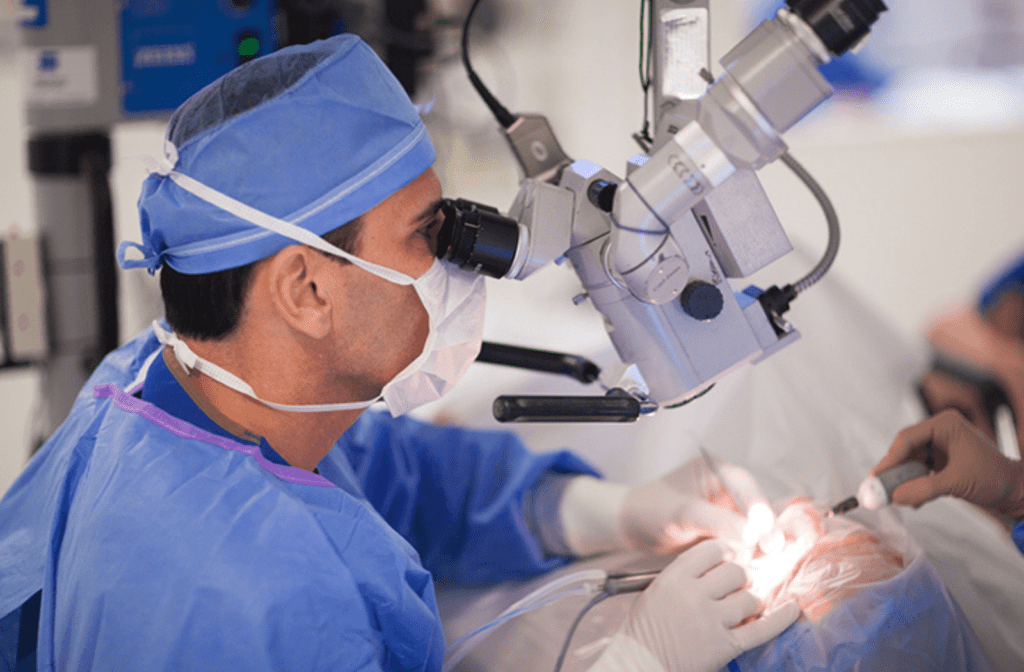Cataracts are a natural part of getting older. While cataracts aren’t necessarily a threat to your health or long-term vision, they can impact your ability to see clearly and perform daily activities.
Usually, cataracts don’t start to cause issues until we reach our mid-40s to early 60s. As they develop, our vision can begin to blur, colors can seem duller, and lights can feel harsher. Eventually, cataracts will have to be removed to retain your vision.
Fortunately, cataract surgery has been widely successful in most patients and is a very common procedure.
What are Cataracts?
Cataracts are the clouding of the normally clear lens of the eye. If cataracts impact your ability to perform daily activities, such as driving or reading, your optometrist may recommend surgery.
When you consider cataract surgery, ask yourself these questions:
- Can I safely do my job?
- Do I struggle to cook, shop, or drive?
- Is my vision affecting my independence?
Cataracts are a natural part of the aging process, but they don’t have to negatively impact your life.
Signs & Symptoms of Cataracts
Signs and symptoms of cataracts include:
- Cloudy, blurry, or dim vision
- Difficulty seeing at night
- Sensitivity to light
- Double vision
- Frequent prescription changes
If you experience any of these symptoms, it may be time to talk to your optometrist about cataract surgery.
Cataract Surgery
Cataract surgery is an operation where your ophthalmologist removes the natural lens of your eye and replaces it with a synthetic lens. This is a generally safe operation.
Before Your Surgery
Your surgeon will perform an ultrasound to measure the shape and size of your eye. This helps determine the right type of lens implant (intraocular lens or “IOL”) to use for your procedure.
IOLs are used in most cataract surgeries. These artificial lenses help focus light on the back of your eye and easily become a permanent part of your eye.
Your doctor will discuss the different types of IOLs with you before your operation. Some IOLs aren’t covered by insurance, so it’s important to understand the cost and benefits of each option. We offer 3 vision option tiers to choose from:
- Advanced Vision: This option includes an extended depth of focus multifocal IOL that allows you to see at all distances, near to far, without glasses.
- Custom Vision: This option provides a single focal point, either near or far. You will need glasses for one focal point with this option.
- Basic Vision: This option removes the cataract, but does not provide enhanced vision.
You should talk to your eye surgeon about the right IOL for you.
Along with your ultrasound, your doctor may prescribe antibiotic eye drops to use for a couple of days before your surgery. This helps prevent infection before your procedure.
Your doctor may also advise you to stop taking some medications temporarily as certain medications can interfere with your surgery. It’s very likely that you’ll be asked fast before your operation.
During Your Surgery
Cataract surgery is typically performed as an outpatient procedure and takes about 2 hours to complete from start to finish.
Your doctor will likely start by putting eye drops in the affected eye to dilate your pupil. This allows your surgeon to get a clearer view of the back of your eye. You’ll also receive a local anesthetic drop to numb the treatment area. You may be given a sedative to help you relax, but you’ll likely be awake for the entire procedure.
Your surgeon will remove the natural lens of your eye, usually through a process called phacoemulsification. This involves creating a small incision in the cornea to insert a thin probe to break up and remove the lens.
After the natural lens is removed, the surgeon will place the artificial lens.
After Your Surgery
After your surgery, you should expect your vision to begin improving after a few days. You may experience blurry vision, mild discomfort, or itching around your eyes as they begin to heal. It’s important to avoid rubbing your eyes after your operation.
You’ll likely have follow-up appointments with your eye doctor in the first couple of days, then a week, and then a month after surgery. It can take about 8 – 12 weeks for your eye to fully heal.
Your doctor may recommend you wear an eye patch or protective shield for a few days after your surgery to increase protection. They may also prescribe eye drops or other medications to use during your recovery to prevent infection, reduce inflammation, and control eye pressure.
Results
After a few days, most of the discomfort should subside. As your eye heals, you may notice that colors seem brighter and there’s less glare around lights. You should begin to see more clearly relatively soon after your procedure.
For people with cataracts in both eyes, your doctor usually schedules your second surgery either a week after your first surgery or after your first eye has fully healed.
If you experience any of the following symptoms during your recovery, contact your doctor immediately:
- Any vision loss
- Persistent pain
- Worsening redness
- Eyelid swelling
- Floaters or flashes
Talk to Your Optometrist
Cataract surgery can restore vision in the majority of patients who get the procedure done. Talk to your ophthalmologist if you experience any symptoms of cataracts. Our team is happy to answer any questions you may have.






